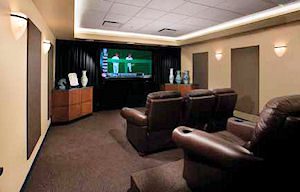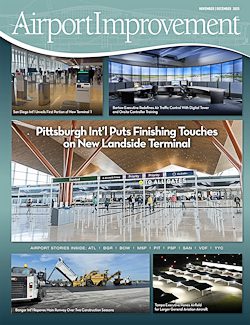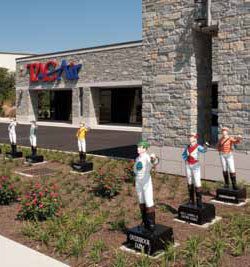 Some people tidy up for special guests. Others go all out. Blue Grass Airport (LEX) in Lexington, KY, rolled out a new $27 million runway and $10 million in terminal enhancements to welcome arrivals for the Alltech FEI World Equestrian Games, held at Kentucky Horse Park this fall. TAC Air, the airport’s resident fixed-base operator, did its part by investing $11 million in a new executive terminal and hangar space.
Some people tidy up for special guests. Others go all out. Blue Grass Airport (LEX) in Lexington, KY, rolled out a new $27 million runway and $10 million in terminal enhancements to welcome arrivals for the Alltech FEI World Equestrian Games, held at Kentucky Horse Park this fall. TAC Air, the airport’s resident fixed-base operator, did its part by investing $11 million in a new executive terminal and hangar space.
As the official airport of the prestigious World Equestrian Games, LEX received numerous foreign dignitaries who arrived for the event via private jets. In fact, general aviation traffic tripled during the games, reports Brian Ellestad, deputy director of air service and community relations for the airport. At peak, LEX managed more than 155 general aviation departures in a single day, notes Ellestad.
Fifty-eight countries, with 632 athletes and 752 horses, were represented at what proved to be one of the largest sporting events in the United States this year.
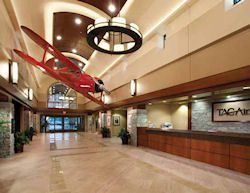 Runway 9-27
Runway 9-27
Several airport improvement projects already in the planning stages were expedited after Lexington was named host of the Equestrian Games in 2005. As the first city outside Europe to host the championships, the stakes were especially high. In addition to building a new $27 million runway, plans for a $10 million terminal renovation and $1.2 million main entrance enhancement were put on the fast track.
While the overall runway project spanned 10 years from inception to completion, major runway design and construction occurred in the last two years, says Mark Day, PE, airport deputy director of engineering and maintenance. The Kentucky Department of Aviation, the Federal Aviation Administration’s Airport Improvement Program and the airport each contributed $9 million to the runway project.
|
Facts & Figures Runway 9-27 Location: Blue Grass Airport, Lexington, KY Cost: $27 million Benefits: Enhanced safety, more room for general aviation parking and hangar development Owner: Lexington-Fayette Urban County Airport Corporation Operator: Lexington-Fayette Urban County Airport Board Engineering Design/Construction Management: RW Armstrong Contractor: ATS Construction Environmental/Airfield Planning: Ricondo & Associates Landside Design: HDR Environmental/Utility Design: EHI Consultants Geotechnical: LE Gregg and Associates Landscape Design: M2D Design Group Survey: Photo Science Geospatial Solutions & Hall Harmon Engineers Aeronautical Survey: Optimal Geomatics Glide Slope Relocation Study: Ohio University Cost Estimation: Connico Incorporated Executive Terminal Location: TAC Air at Blue Grass Airport Cost: $11 million (including hangar improvements) Operator: TAC Air, a division of Truman Arnold Companies Design-Builder: Hayden Company Architect: Jerry Herndon Interior Design: Bethune/Goodhue & Associates Art Consultant & Installation: South Hill Gallery |
 Preliminaries
Preliminaries
Before creating the new runway, the airport had obstacles to jump. An environmental assessment developed by Ricondo & Associates revealed several challenges: Nearby highway U.S. 60 is a protected scenic corridor; some area farms are permanently protected by conservation easements; and the neighboring Keeneland thoroughbred racetrack is a national historic landmark.
“We looked at how the runway and the new general aviation facilities would affect views from the Keeneland grand stands, and if moving the runway closer to the racetrack could potentially affect the horses racing there,” recalls Stephen Culberson, Ricondo & Associates project manager.
As a result, trees and other landscaping are being planted along the track and on the airport’s property to provide visual screening. Decorative black vinyl fencing was used along the scenic corridor rather than traditional chain-link perimeter fencing out of respect for the local landscape and character.
Initially, homeowners in a subdivision east of the proposed runway expressed concern about increased aircraft noise, recounts Culberson. After listening to the concerns, project team members rotated the runway slightly to mitigate the noise and visual impact of approaching and departing aircraft. The small modification produced levels similar to those homeowners had experienced with the previous runway. Trees help blend the new runway and general aviation facilities into the rural area surrounding the airport.
When the draft environmental assessment was released, Culberson says citizens were complimentary and seemed pleased their concerns had been addressed.
The land itself was not an easy lot. Property acquisition caused delays and was ultimately resolved in arbitration. Then, more than 1.25 million cubic yards of earth had to be moved because of the rolling terrain. An exceptionally wet spring, which produced occasional sinkholes, further slowed the process, recalls RW Armstrong senior project manager Christopher Coons, PE. RW Armstrong designed the runway and was the prime engineering and construction consultant for the project.
Initially, the new runway construction was bid to Airport Reference Code (ARC) B-II Runway Safety Area grading requirements with consideration for future plans to increase to ARC C-II. But when the economic downturn in fall 2008 led to lower-than-anticipated construction bid results, the airport was able to proceed with C-II requirements, reports Coons.
Another change was the airfield pavement material. Originally, Runway 9-27 was to be constructed of asphalt, but based on recent construction pricing trends and the FAA’s 20-year lifecycle cost analysis, the team decided that Portland Cement Concrete would be the most cost-effective pavement material. More than 31,000 cubic yards of concrete were used to form the new runway, full-length parallel taxiway and aircraft parking apron.
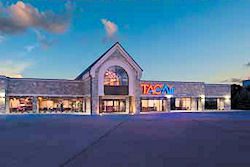 Endurance
Endurance
Coons credits ATS Construction for making up time lost to weather delays. He says the general contractor’s involvement in all phases of the construction helped drive cost and schedule efficiencies that enabled the project to be completed on time and within budget.
About midway through the design process, the FAA requested that a parallel taxiway be added to the project scope.
“We designed the parallel taxiway in a very aggressive two-month timeframe to complete everything before the games,” Coons recalls.
Other components of the runway project included relocating existing Navaids and installing a new electrical vault.
Coons is proud of delivering what he considers a high-quality project under an aggressive schedule: “We met all of the originally planned program goals and delivered on time for the equestrian games, which helped the airport and the community create a world-class first impression.”
In addition to it’s new excutive terminal, TAC Air added three new hangars and refurbished existing hangers.
Creating the Wow

Another main component of pre-event infrastructure improvements occurred at the airport’s fixed-base operator (FBO). TAC Air, a division of Truman Arnold Companies, has been operating at LEX for 13 years. After being awarded a new contract, it announced plans to build a new 12,000-square-foot terminal. Per Tac Air’s lease agreement with the airport, its $11 million investment in terminal and hangar improvements will be turned over to the airport at the end of the 20-year lease.
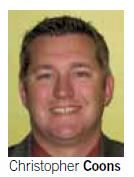 TAC Air marketing director David Edwards says that it was refreshing to work with the LEX board. “We see a disturbing trend of airports trying to build FBOs using government funding,” Edwards explains. “In our opinion, everyone would be better served if money available to airports was spent on runways and general public terminals, and private business handled meeting the market demands and building the structures for general aviation.
TAC Air marketing director David Edwards says that it was refreshing to work with the LEX board. “We see a disturbing trend of airports trying to build FBOs using government funding,” Edwards explains. “In our opinion, everyone would be better served if money available to airports was spent on runways and general public terminals, and private business handled meeting the market demands and building the structures for general aviation.
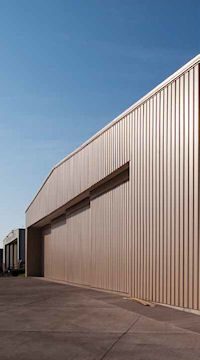 “There’s a danger with airports artificially introducing FBOs the free market did not already support. Everyone loses. When a fixed level of traffic is divided among more FBOs than what the free market has produced, the revenue (per FBO) decreases, resulting in an erosion of services to keep the doors open. The general public loses because funding that should have contributed to the betterment of the airport as a whole is gone.”
“There’s a danger with airports artificially introducing FBOs the free market did not already support. Everyone loses. When a fixed level of traffic is divided among more FBOs than what the free market has produced, the revenue (per FBO) decreases, resulting in an erosion of services to keep the doors open. The general public loses because funding that should have contributed to the betterment of the airport as a whole is gone.”
A bright red model of a 1937 Staggerwing suspended from the ceiling of the new terminal’s atrium symbolizes the timing of TAC Air’s investment at LEX. Greg Arnold, president and CEO of Truman Arnold Companies, likens the current general aviation market to the challenging conditions that prevailed when Beechcraft introduced the aircraft in the 1930s.
But when it came time for the 2010 World Equestrian Games, TAC Air was chomping at the bit to provide world-class customer service from its first executive terminal built from the ground up.
Handling traffic associated with such a huge international event just weeks after the facility opened was a “daunting task,” acknowledges Kip Simanek, TAC Air LEX general manager. But things went smoothly, he reports: “We had the luxury of bringing over line and counter personnel from other locations in the region. Some knew our systems and could hit the ground running, providing our services.”
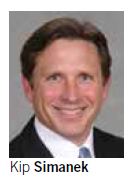 |
 |
“General aviation is a highly competitive industry, and attention to detail at every level of design is critical to a successful project,” says Goodhue. “Layout, lighting, aesthetics, signage, amenities and overall comfort of the space all influence the selection of an FBO.”
TAC Air establishes its brand with warm, friendly materials such as rich wood tones, relaxing colors and comfortable furnishings, she explains. “Though there are regional influences from base to base, when you walk in, you know you’re at TAC Air,” she relates.
Local artwork helps create a sense of arrival in Lexington. A large corridor gallery created with the help of Lexington’s South Hill Gallery features 16 works in various media. “We used local artists, architects, contractors and suppliers as much as possible, and were extremely pleased with the results,” notes Edwards.
The directive given to local architect Jerry Herndon, AIA, was to create a building that reflected the Bluegrass State and create a “wow.” An exterior Kentucky limestone façade, green metal roof and traditional carriage lights fit the bill for airport officials.
“Just like our newly renovated terminal, the new TAC Air building is a great first impression for all of our guests,” says Ellestad. “It’s a beautiful facility.”
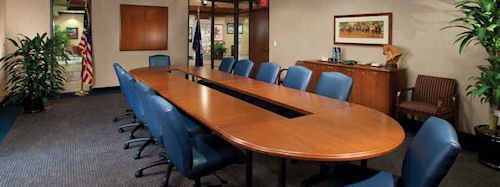
Herndon says he was impressed that TAC Air was willing to spend the money it takes to create a true “attention-getter.”
Upscale amenities for pilots include a high-definition movie theater, exercise facilities, wireless printing from laptops and smart phones, showers, two private sleep rooms and a lounge. The pilot restrooms are patterned after hotel restrooms, with more space than usual and full doors rather than partitions. Two conference rooms and a cafe are also available.
|
TAC Air’s amenities include a high-definition movie theater, exercise facilities and conference room. |
Other than hanging the 1,300-pound fabric and wood aircraft model in the atrium, Dan Douglas, project manager for general contractor Hayden Company, says the project didn’t include many logistic issues.
Hayden’s executive vice president, Wayne Hayden, says the design-build process went smoothly because project team members kept in constant contact. Hayden was responsible for hiring the architect and engineers for the project.
In addition to the new terminal, TAC Air added three new hangars, totaling 45,000 square feet, and refurbished old hangars.
Both the runway project and TAC Air terminal construction had photo finishes. Ribbon cutting for the executive terminal occurred on July 28, followed by ribbon cutting for the runway on Aug. 4 and the official opening of the equestrian games on Sept. 25.
Runway 9-27 cost $27 million and represents roughly half of the improvements made at Blue Grass Airport in the past two years.
Horses & Jets
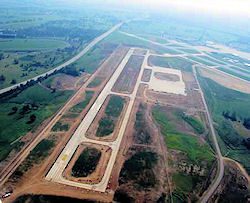
Many of the more than 1 million passengers who fly into LEX contribute to Kentucky’s estimated $4 billion horse economy. General aviation, notes Ellestad, makes up more than 60% of the airport’s operations.
“We have a high percentage of private planes that come into our area because of the horse industry,” says Herndon, who lives in Lexington. “We felt having a
special facility at the airport for those folks was extremely important, and we felt we were successful in providing that.”
The Lexington Convention and Visitors Bureau points to views flying into the newly improved airport as proof-positive that Lexington is, indeed, the Horse Capital of the World.
“You fly in over all the signature horse farms. You see the signature white fencing. It’s a very picturesque arrival,” agrees Ellestad.

